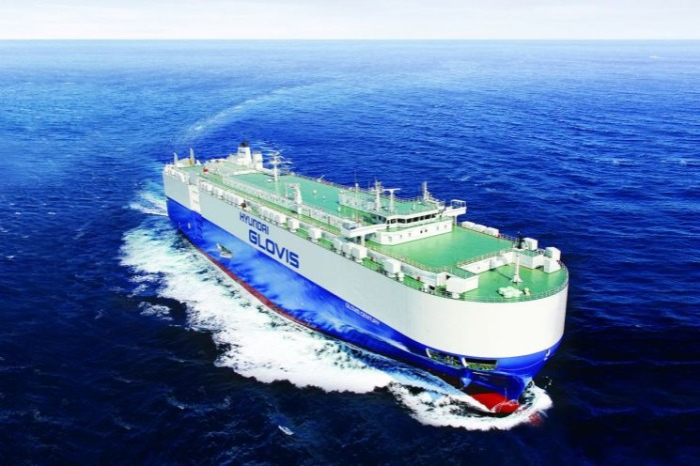Shipping & Shipbuilding
Hyundai Glovis adopts system to meet US' green policies on car carriers
The global No. 3 car shipping firm will use Stax's maritime emission reduction system to adhere to California regulations
By May 27, 2024 (Gmt+09:00)
2
Min read
Most Read
LG Chem to sell water filter business to Glenwood PE for $692 million


Kyobo Life poised to buy Japan’s SBI Group-owned savings bank


KT&G eyes overseas M&A after rejecting activist fund's offer


StockX in merger talks with Naver’s online reseller Kream


Mirae Asset to be named Korea Post’s core real estate fund operator



Hyundai Glovis Co., the world’s third-largest car shipping company, is set to introduce an emission reduction system for its vehicle carriers entering California to respond to the US state’s environmental regulations.
The logistics unit of South Korea’s Hyundai Motor Group said on Monday it has signed an agreement with US-based Stax Engineering Inc. to capture and control its car carriers' maritime emissions.
Hyundai Glovis will introduce Stax’s system to its pure car and truck carriers (PCTC) that will be docked at the ports of Benicia, Los Angeles, Long Beach and Huenemein the US state from January 2024.
Stax’s system can remove up to 99% of diesel particulate matter (PM) and 95% of nitrogen oxide (NOx) before releasing them as purified gas. The company said last month that it has treated parked ships for a cumulative of 3,200 hours and 23 tons of pollutants.
The partnership between the Korean ocean carrier and Stax will respond to regulations by the California Air Resources Board (CARB), which requires carriers docked at the US state’s ports to reduce NOx and fine PM.
CARB started implementing the regulations for container lines entering California last year and will apply them to car carriers starting in January of next year.
Hyundai Glovis also plans to introduce a ship emission capture and control system for its vehicle cargo ships entering San Diego, a major hub of vehicle logistics, and own 30 automobile carriers embedded with liquefied natural gas dual-fuel engines by 2028.
The company expects the carriers, which will use the alternative maritime power (AMP) system for emissions reduction, to meet the standards of the European Union’s Emissions Trading System (ETS). The system will also achieve the Korean government’s goal of providing electricity to parked ships at 248 spots at 13 key domestic ports, Hyundai Glovis said.
The company operated 72 vehicle transport ships as of August 2023 and plans to introduce up to 12 additional auto carriers by 2025.
It expects an improvement in earnings this year amid an increase in inland delivery of cars in overseas markets and high car shipping rates, despite unfavorable conditions such as the Israel-Gaza war-triggered delays in Red Sea operations.
In its regulatory filing in April, Hyundai Glovis posted 384.8 billion won ($282.2 million) in the first-quarter operating profit, down 5.4% from a year earlier. This beat the market consensus of 364.3 billion in profit in a survey conducted by Seoul-based financial data service provider Yonhap Infomax. Sales rose 4.5% over the same period to 6.6 trillion won.
Write to Jung-Eun Shin at newyearis@hankyung.com
Jihyun Kim edited this article.
More to Read
-
 EarningsHyundai Glovis expects better 2024 after beating market in Q1
EarningsHyundai Glovis expects better 2024 after beating market in Q1Apr 25, 2024 (Gmt+09:00)
3 Min read -
 Shipping & ShipbuildingHMM, Hyundai Glovis aim for car shipping sector as rates jump
Shipping & ShipbuildingHMM, Hyundai Glovis aim for car shipping sector as rates jumpFeb 20, 2024 (Gmt+09:00)
4 Min read -
 LogisticsHyundai Glovis to raise car shipping rates amid vehicle carrier shortage
LogisticsHyundai Glovis to raise car shipping rates amid vehicle carrier shortageSep 04, 2023 (Gmt+09:00)
2 Min read -
 LogisticsHyundai Glovis, Malaysia’s Lion Group to enter ASEAN logistics market
LogisticsHyundai Glovis, Malaysia’s Lion Group to enter ASEAN logistics marketNov 16, 2022 (Gmt+09:00)
1 Min read
Comment 0
LOG IN


